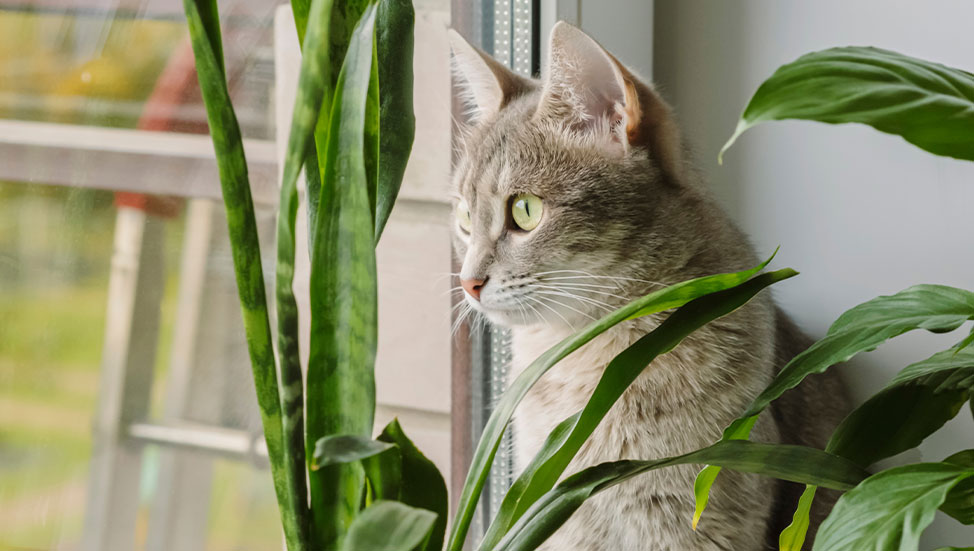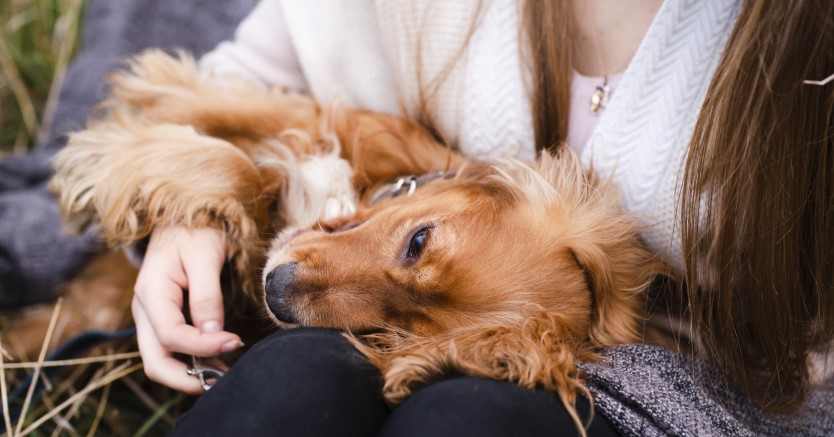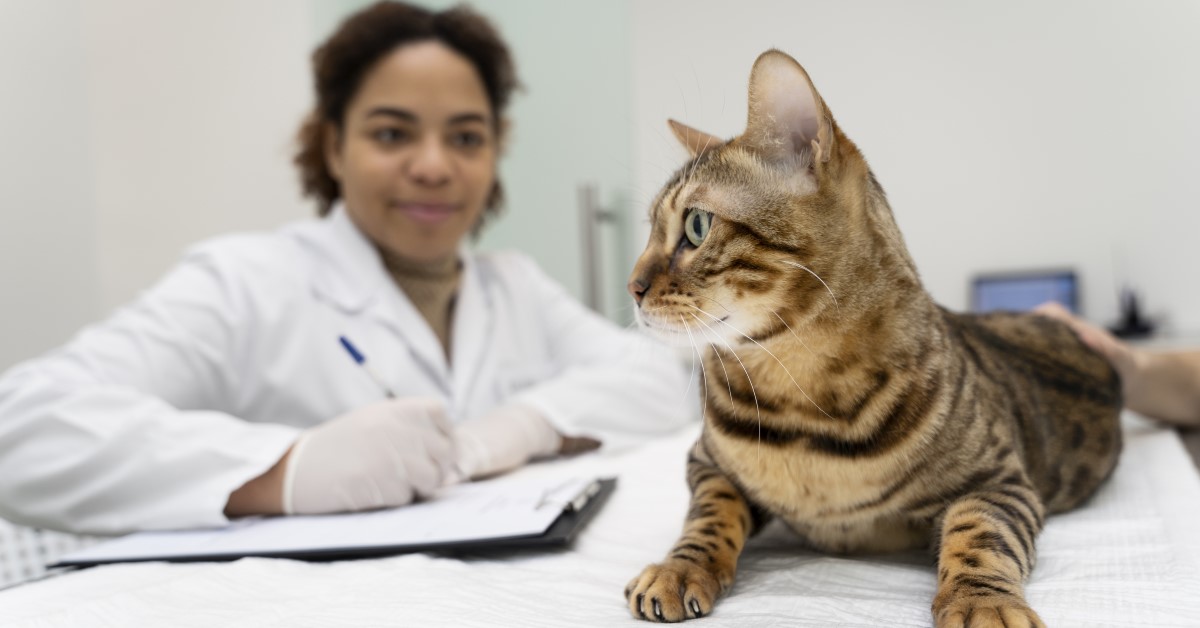Pets and plants living in harmony
Whether you're introducing your first plant into your home or your first pet, it's important to note the dangers that can come with the two cohabiting. In this blog, we'll examine the most common houseplants, the dangers each may pose, and how to keep your pet our of harms way.

Pets and plants just seem to go together. Catching sight of a vibrant, thriving plant or your favorite four legged friend is guaranteed to put a smile on your face. They’re both extremely beneficial when it comes to mental and physical health.
Plants clean the air in a home and improve a person’s overall mood. Owning a pet has been proven to lower blood pressure and cholesterol while providing companionship. Both also signify taking a step further into independence, and making a house more of a home.
It’s not too surprising that many people have both pets and houseplants. Unfortunately, despite how beneficial both are, they don’t exactly live together in perfect harmony.
Aside from digging into soil, using plants to relieve themselves, or potentially knocking pots over in a fit of excitement, pets may entertain the bad habit of gnawing on or eating your plants – and this can cause a lot of health issues. These issues range in severity and the need for medical intervention. But if you’re a pet owner living in a plant-filled house, or a pet owner looking to liven up your living space with some flora, it’s important to know what plants can be toxic to your companions and which are safe to have around.
The Danger Zone
Houseplants add color and texture to a home, as well as the satisfying feeling of being surrounded by other quiet, living beings. Unfortunately a lot of houseplants that people know and love are harmful to a number of pets. More affordable, common varieties might look cute and inconspicuous, but all it takes is one leaf, root, or berry for something to go wrong.
On the flip side, a number of these plants are toxic to humans too, we’re just never tempted to eat them. Animals, being naturally curious – especially puppies and kittens – will find their way into trouble easily. Having unsupervised access to houseplants is an easy way for pets to make themselves sick.
Here’s a list of common houseplants and the side effects you might see if your pet has ingested them:
MILD
- Asparagus Fern – An airy-looking, beautifully textured fern, the asparagus fern is easy to keep. They can be used in hanging baskets, on porches, or indoors in pots. Side effects: Skin irritation, vomiting/diarrhea from ingesting berries.
- Begonia – Many people either love or hate begonias. Their thick-petaled, vibrant flowers give homes a tropical touch. Side effects: Severe oral irritation
- Ficus – Perhaps the most common houseplant, the ficus has leathery leaves and can usually be found in large pots that make it a great option for spacious rooms. Side effects: Vomiting, drooling, loss of appetite, painful mouth.
- Peace Lily – Peace lilies are quite distinct with their single petaled, white flower. Side effects: Vomiting, mouth irritation.
MODERATE
- Aloe – Aloe plants are a great plant to have around just for the sake of their medicinal uses (for humans). But they definitely don’t benefit pets the same way. Aside from the spikes on the body of the plant being dangerous for the digestive system, they’re also toxic. Side effects: Vomiting, diarrhea, lethargy.
- Elephant Ear – Known for their massive leaves, elephant ears are a bold, tropical statement in any house. Side effects: Increased saliva, drooling, vomiting, difficulty swallowing.
- Hyacinth – Hyacinths are commonly given as gifts around spring and the Easter holiday. They have a powerful, sweet scent and come in bright colors. Side effects: Tremors, severe vomiting, diarrhea with blood.
SEVERE
- Easter Lily – The Easter lily is a plant commonly given as a gift. The trumpeted flowers are large and smell sweet. Side effects: Can be fatal to cats, affects appetite and causes kidney failure.
- Ivy – An easy plant to keep with a whimsical, climbing aesthetic, ivy makes a great houseplant. Side effects: In dogs, rashes and breathing problems. Can also cause comas or paralysis.
- Jade – Jade plants go by many names (luck plant, money tree) and are extremely cute with their stout stature and thick, succulent leaves. Side effects: Vomiting, incoordination, slowing of the heart rate.
- Sago Palm – Distinctly tropical in their appearance, the sago palm is a favorite due to its feathery foliage. Side effects: Roots, leaves, and seeds are poisonous; diarrhea, vomiting, liver failure.
Living in Harmony: Plants and Pets
The obvious choice is to steer clear of any of the above plants if you live in a household with pets. The houseplants on that list are some of the most common, but there are many others that can cause temporary gastrointestinal issues or problems as severe as organ failure.
So how can you keep your pet safe in a house full of plants? Here are a few things to consider:
- Keep plants out of reach. This might seem like common sense, but pet owners are always surprised at how agile their furry companions are. A great option is hanging pots instead of putting them on nightstands or low to the floor.
- Block off plant areas/rooms. Having a specific room for your plants is a great idea for many reasons; ease of care, having a space to sit back and relax, and easy supervision. Shutting a door and closing off an area is a logical way to your pets separated from your plants.
- One of the simplest, and easiest, solutions. Did you come across an interesting plant at a farmer’s market or greenhouse? Ask an employee for more information, or do some quick research of your own on your phone to find out if this particular species might be harmful to pets.
- Use repellents. Interestingly enough, some plants can serve as natural repellents. For example, cats usually despise lavender and thyme, and will steer clear of their strong scents. Mixing these herbs in with your other plants might be a good way to stave off your curious feline. Spray repellents – usually citrus scented – also work well.
- Provide distractions. Your pet might be messing with plants simply because they’re bored. Having enough toys around and accessible to keep them occupied will help curb their curiosity.
- Know who to call. In the event that your pet does ingest any part of a plant, whether you know that it’s toxic or not, it’s important to have a reliable vet’s contact information readily available. Keep an eye out for any unusual symptoms and behaviors, take pictures, and don’t waste time – talk to an expert as soon as you can so you know what to expect and how to approach any potential issues.
You can also research some of the less popular houseplants that aren’t harmful to pets. These include the spunky hens-and-chicks combo, burro’s tail, air-cleansing spider plants, African violets, bamboo, and many more!
Maintaining a shared space with pets and houseplants isn’t impossible, it just involves a little research, planning, and light supervision. In the end everyone will be happy, healthy, and safe.
Ready to start saving money on pet wellness care?
Then take a look at Mint Wellness, the pet wellness plan that provides fast reimbursement on routine pet care. Save on vaccinations, wellness exams, preventatives, dental, and more!
Learn More


